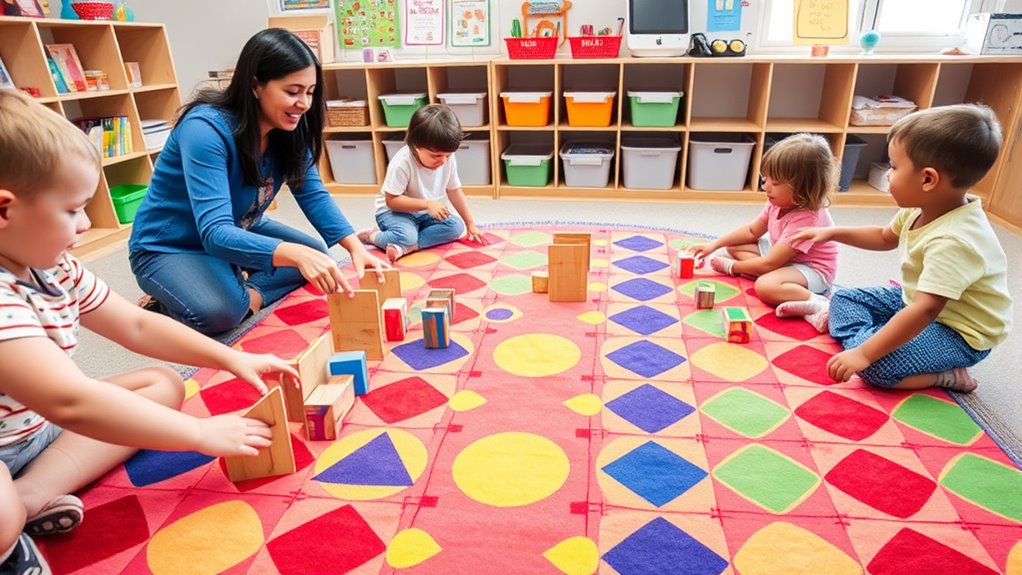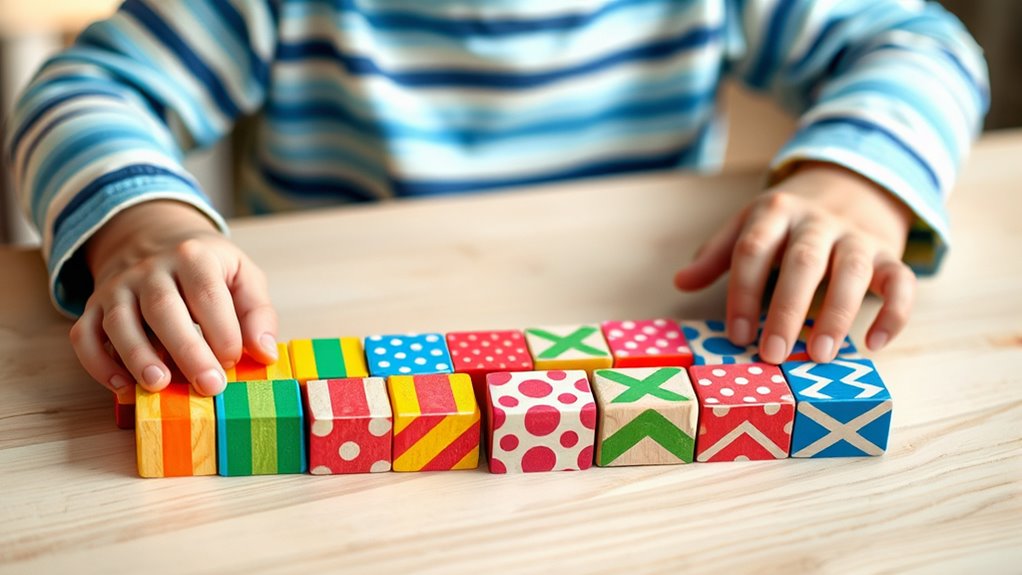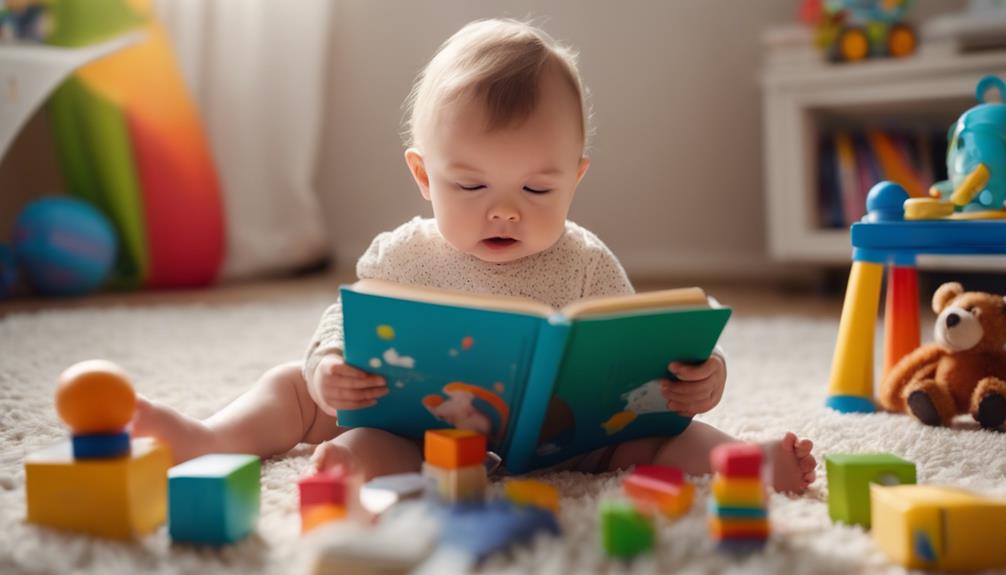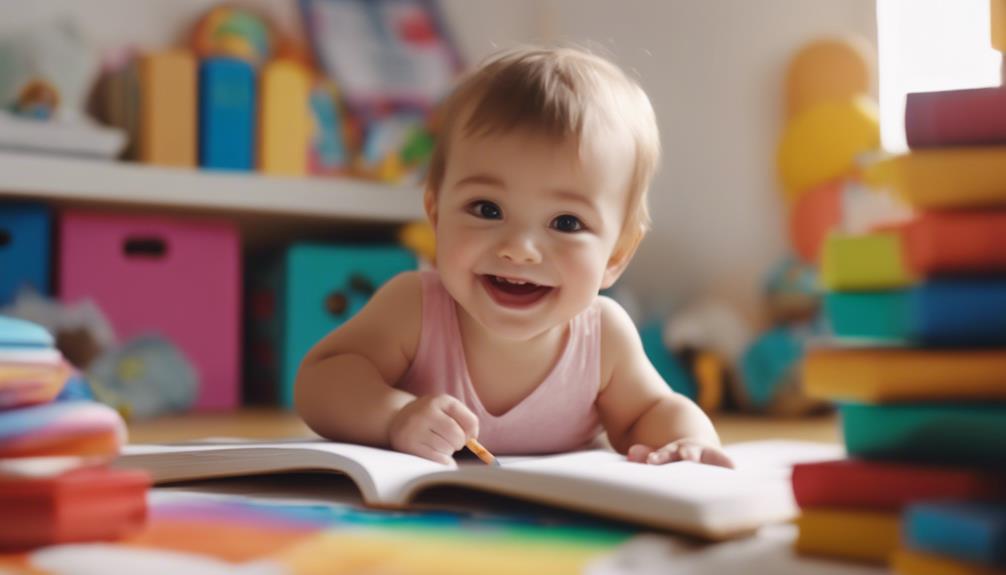To teach sequencing and patterns easily, start with hands-on activities like sorting objects by color, size, or shape, and creating simple patterns with blocks or beads. Incorporate movement by clapping, stomping, or jumping in specific sequences to make learning fun and multisensory. Visual activities like drawing or placing stickers help children invent and extend patterns. Connecting patterns to stories or real-world scenarios keeps children engaged. Keep exploring for more creative ways to build pattern skills effectively.
Key Takeaways
- Start with sorting objects by color, size, or shape to introduce basic pattern recognition skills.
- Use movement activities like clapping or stomping in sequences to engage children physically.
- Create visual patterns with drawing, stickers, or blocks to develop pattern understanding and creativity.
- Incorporate storytelling or real-world scenarios, such as treasure hunts, to contextualize pattern activities.
- Encourage children to extend or invent patterns independently to reinforce sequencing and critical thinking.

Have you ever noticed how patterns can transform the way we see the world around us? Recognizing patterns isn’t just about spotting repetitive designs; it’s a fundamental skill that shapes how we understand sequences and structure in everyday life. When you introduce pattern recognition to children, you’re helping them develop critical thinking and problem-solving skills. One of the most engaging ways to do this is through creative sequencing activities. These activities encourage kids to observe, predict, and create patterns, making learning both fun and meaningful.
Start with simple, tangible activities like sorting objects by color, size, or shape. For example, gather a handful of blocks or beads and ask children to arrange them in a pattern—red, blue, red, blue—or small, medium, large, small, medium, large. This not only reinforces pattern recognition but also introduces the concept of sequencing, where each item follows a specific order. As they become more confident, you can challenge them to extend the pattern or create their own. This process promotes creative sequencing, where children learn to think ahead and organize elements systematically.
You can also incorporate movement into your pattern activities. For instance, create a pattern with claps, stomps, or jumps—clap, stomp, clap, jump—and have your child mimic or continue the sequence. Moving their body to follow patterns helps reinforce recognition in a multisensory way, making the learning experience more dynamic. Plus, it adds an element of play, which keeps children engaged and enthusiastic to participate. As they master simple patterns, introduce more complex sequences involving multiple elements, like colors and sounds together. This challenges their ability to recognize patterns across different modalities and enhances their creative sequencing skills.
Another fun activity involves drawing or using stickers to create visual patterns on paper. You might start with a sequence of shapes or symbols and ask your child to replicate or extend it. Encourage them to come up with their own patterns, fostering creativity and deeper understanding of the concept. You can even turn pattern creation into a story or game, where each pattern represents a step in a narrative or a clue in a treasure hunt. This storytelling approach makes pattern recognition meaningful and relatable, connecting abstract concepts to real-world contexts. Incorporating visual perception techniques can further strengthen their pattern recognition abilities.
Frequently Asked Questions
How Can I Adapt Pattern Activities for Different Learning Styles?
When adapting pattern activities for different learning styles, you should incorporate multisensory approaches and visual aids. For kinesthetic learners, include hands-on materials like beads or blocks. Visual learners benefit from colorful charts or pattern cards. Auditory learners respond well to verbal instructions or rhythmic patterns. By combining these strategies, you create engaging, accessible activities that cater to everyone’s strengths, making pattern learning more effective and enjoyable for all students.
What Are Some Common Mistakes to Avoid When Teaching Sequencing?
When teaching sequencing, avoid common mistakes like causing sequence confusion by rushing through steps or skipping foundational concepts. Be careful with pattern overgeneralization, where students apply rules too broadly, leading to misunderstandings. To prevent these issues, make certain you give clear, step-by-step instructions, reinforce each pattern, and check for understanding before progressing. This approach helps students confidently grasp sequencing and pattern recognition without feeling overwhelmed or confused.
How Do I Assess a Child’s Understanding of Patterns Effectively?
Evaluating a child’s understanding of patterns requires keen observation and strategic assessment strategies. You should watch for how confidently they complete pattern tasks, noticing their problem-solving progress. Use observation techniques like noting their steps, hesitations, and explanations. Ask open-ended questions to gauge comprehension. By combining these methods, you’ll clearly see their grasp of sequencing, helping you tailor your teaching to support their pattern proficiency.
Are There Digital Tools to Enhance Pattern Recognition Skills?
You can definitely use digital apps and pattern games to boost a child’s pattern recognition skills. These tools make learning interactive and fun, helping children identify sequences and complete patterns. Look for apps that offer engaging activities tailored to their age, and encourage regular practice. Using these digital tools alongside hands-on activities can strengthen their understanding and make pattern recognition an enjoyable part of their learning journey.
How Early Can Children Start Learning About Patterns and Sequencing?
Think of learning patterns like planting seeds early in a garden. Children can start exploring patterns and sequencing as young as infancy, around 6-12 months, by recognizing simple repetitions. Early exposure helps meet developmental milestones, laying a foundation for more complex skills later. You’ll notice toddlers sorting shapes or imitating rhythms, showing they naturally gravitate toward understanding sequences. The sooner they start, the stronger their pattern recognition grows.
Conclusion
Now that you have these fun activities in your toolkit, you’re like a gardener planting seeds of curiosity and growth. Watching your students blossom as they master sequencing and patterns is truly rewarding—each step building a colorful mosaic of understanding. Remember, teaching patterns is like weaving a vibrant tapestry; with patience and creativity, you’ll help your students see the beauty in order and repetition. Keep playing, exploring, and inspiring—your classroom is a garden of endless possibilities.










